It’s a Monday night (25 July), just another school night in Sydney, but at 7pm sharp, the broad plaza near the Qudos Bank Arena is already filling up with nu-goths, old goths, 40-and 50-somethings.
In fact, an entire, broad sweep of converts to The Cure’s sometimes-curious mix of thunderous drones, melodic rock and power-pop hits. Welcomed onstage to a mixtape of instrumental trance and 1930s jazz tunes, The Cure straps on, straight into 'Disintegration’s ‘Plainsong’. It’s been 27 years since Robert Smith wrote the lines: “I think I’m old/ and I’m in pain”, and yet the intervening years slip away smartly.
 The Cure at Splendour 2016 - image © Carl Neumann
The Cure at Splendour 2016 - image © Carl NeumannThe audience rolls with the songs, swaying easily as the tempo slips into gear for the first couple of songs. The latest line-up, fixed since 2012, delivers punch after chart topping punch in a nearly three-hour set, along with some rarities. ‘Like Cockatoos’, the deadly swing of which Smith casually notes: “I wrote this one just down the road from here, in 1980. I was 21.”
For the casual fan, the set is paced excellently: for every instrumental or long intro/ outro, there comes the immediately familiar ‘Pictures Of You’ and ‘Just Like Heaven’. For the hardcore fans, dancing in the aisles to songs like ‘Push’ and ‘All I Want’, there’s ‘In Between Days’, which sees the group delivering heartbreakers of old with new energy and subtle rearrangements.
 The Cure at Splendour 2016 - image © Carl Neumann
The Cure at Splendour 2016 - image © Carl NeumannSmith, his once-trademarked flourish of black hair now left to fade to a more reassuring grey, leads a line-up of the band which is as musically tight as it is limber. Simon Gallup patrols the stage as if cut from Paul Simenon’s slightly nervous/ aggressive jib, all low-slung bass and wicked rockabilly quiff.
Smith and ‘new’ guitarist Reeves Gabrels trade shaded licks, before Gabrels launches into the stratosphere with his tasteful short leads, adding a needling colour to Smith’s songs, as he once did for the late David Bowie. Likewise, a welcome inclusion of ‘One Hundred Years’ (from 1982’s 'Pornography') showcases the band’s more slippery side of the early 1980s, a decade which proved a memorable era for their most experimental and popular hits.
 The Cure at Splendour 2016 - image © Carl Neumann
The Cure at Splendour 2016 - image © Carl NeumannAs the band moved off stage for a short break, it was clear things were just starting to accelerate. The first three-song encore was an almost monochrome mini-set, culminating in ‘Primary’, a favourite of many of the attendees over 45, while encore two was starting to get noisier.
By the time they moved into the third encore, they were delivering hit upon hit: ‘Lullaby’, ‘Hot Hot Hot!’ and their 1992 mega-smash ‘Friday I’m in Love’. By the time the group takes their fourth and final encore, the audience is easily transported back to the mid-1980s with ‘Lovecats’, ‘The Caterpillar’ and finally, the one-two punch of ‘Why Can’t I Be You?’ and ‘Boys Don’t Cry’.
 The Cure - image © Carl Neumann
The Cure - image © Carl NeumannThe proof is that, despite the occasional lapses into mid-tempo, Robert Smith and The Cure have amassed a back catalogue that defies easy categorisation, not to mention cross-generational age appeal. The Cure have no use-by date, no ‘best before’, and they’re still having a staunchly-unsmiling good time.






